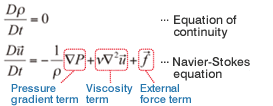HOME / Software / MPS-RYUJIN : Moving Particle Semi-implicit (MPS) theory
MPS (Moving Particle Simulation) method
Summary MPS-RYUJIN Solver uses the particle method, which represents the continuum by means of a finite number of particles.
The motion of fluid particles gets updated in accordance with a motion equation, while the discretization of the equation utilizes inter-particle interaction and the MPS method.
This method is mainly intended for incompressible fluids, with the calculations using semi-explicit and semi-implicit algorithms.
Governing equation of incompressible flows

Calculation procedure
(1) Calculate the viscosity and external force terms utilizing previously acquired values, and obtain the tentative speed and position of particles (explicit calculation).
A Laplacian model and the MPS method are used for calculating the viscosity term.
(2) Write a Poisson's equation based on the conditions of a consistent density, and then solve the equation to acquire the particle pressure (implicit calculation).
(3) Calculate the pressure gradient term using the pressure obtained in (2), and then modify the speed and position of the particles.
Use a gradient model and the MPS method to calculate the gradient.
(4) Output the calculation result, and then return to (1) if it does not satisfy the termination condition.
Consideration of negative pressure in RYUJIN
Negative pressure denotes any pressure that is lower than standard, or in terms of MPS-RYUJIN, basically refers to any pressure that is lower than that on the free surface (atmospheric pressure).
Consider the case where polygons in liquid rapidly accelerate as an example. Negative pressure not being taken into consideration results in the space generated between the polygons and particles being determined to be a free surface, and hence the difference in pressure that fills that space does not get generated. In contrast to this if the negative pressure taken into consideration it then gets generated for the space, and subsequently the difference in pressure that fills the space between the polygons and particles is generated.

Calculation of surface flow and flow velocity
MPS-RYUJIN is equipped with a function that measures the number of particles flowing over the surface of polygons. The measurement uses the method indicated in the figure on the right.
A virtual triangle (Default height = Particle diameter x Radius of influence) is set up in the normal direction of a polygon. Particles enter the space, and are then counted at the moment when they exit the space. They are not weighted according to distance or differentiated by the location of their entrance (upper or side).
With calculation of flow velocity the average velocity of the particles within the space shown in the figure is calculated.

Calculation of torque values via the particle method
MPS-RYUJIN calculates torque values as the reaction to the force that gears exert on fluids :

The value obtained after calculating the viscosity and pressure gradient terms with a Navier-Stokes equation is used for the force that a gear exerts on particles.
In addition, the inertial force of the gear is taken into consideration and reflected in the flow when required.
Heat calculation in particle method
Heat generally transfers through fluid migration and heat conduction in fluids. With the particle method, which utilizes the Lagrangian method, however, particles as used calculation points are considered to migrate, thus meaning that the heat conduction between particles should be the only factor to be taken into consideration. The calculations retain the temperature of each particle as a variable. The calculated heat conductions then takes into account the heat sourcesassociated with the boundary conditions as well as any internal heat generated by the viscosity dissipating. The particle motion is thencalculated for use in the analysis.

Surface tension
The MPS-RYUJIN utilizes a surface tension model generated using the inter-particle attraction to represent the wettability. The model utilizes an attraction that is similar to the intermolecular force between particles (fluid-fluid or fluid-wall) to consequently show the behavior to be like surface tension.
This also enables the integrated consideration of the wettability of walls, and which can be used to control the scale of the attraction between fluid particles and wall particles that are depend on the contact angle.

Parallel computing of MPS-RYUJIN Solver
MPS-RYUJIN executes parallel computing that combines SMP with MPI, thereby achieving more efficient and faster parallel computing, although depending on the user environment and the details of the analysis. The differences in the parallel methods are listed below :
| Parallel method | SMP | MPI | Hybrid |
|---|---|---|---|
| Memory space | Shared in enclosure | Segmented for each calculation core | Shared in the same process |
| Communication | NA | Communication between all calculation cores | Communication between memory spaces |

Product overview /
Moving Particle Semi-implicit (MPS) theory /
Fluid analysis solver functions
Pre and post processing /
Sample analysis scenarios /
New features /
Product seminars








